Over time, it adds up: failed prints, support material, prototype iterations, and filament snippets. If you have boxes of 3D printing plastic waste, you’re not alone.
What to do with it?
If you throw it in the trash, it will go to a landfill, where it will take at least hundreds of years to degrade (yes, including PLA!). If you throw it in with your household plastic recycling, it will very likely be separated at the recycling facility (because the type of plastic is unknown) and sent to an incinerator or a landfill. If you send it to the food waste composter, it will most certainly be separated out and, again, sent to an incinerator or a landfill. If you bring it to an industrial waste management facility, it can be either recycled into a low-grade plastic shred used in some types of manufacturing or, in the case of PLA, shredded and treated so that it will biodegrade much faster (a few months).
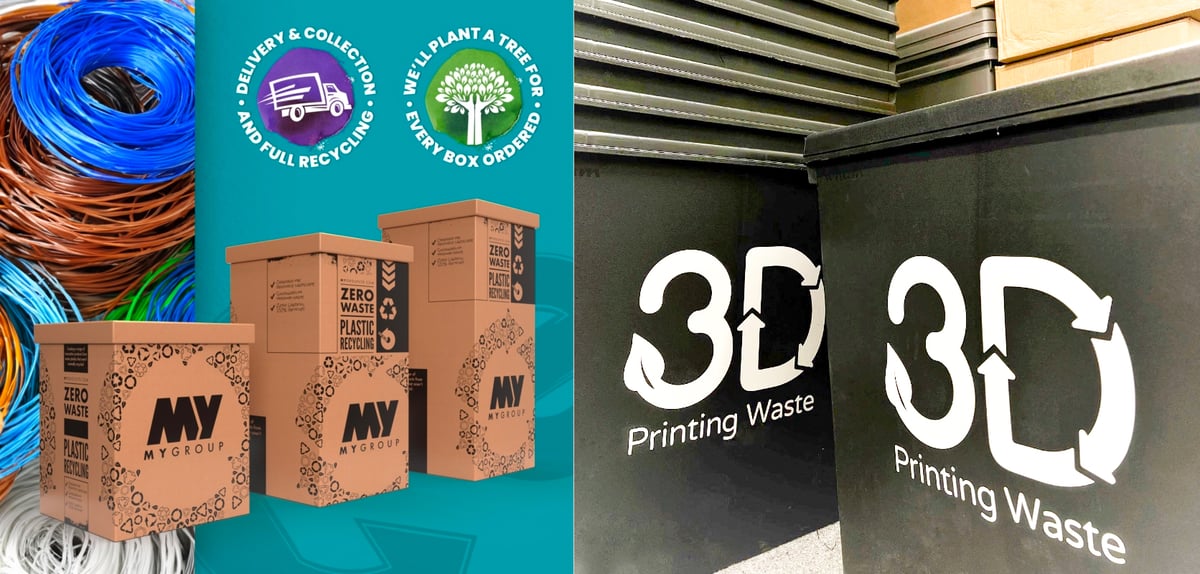
You could buy a recycling setup and filament extruder for your home or an industrial one for your business and turn your scraps into new filaments. But if you’re simply not printing enough volume to make the equipment investment worthwhile or you do not have the resources to take recycling in-house, there’s another way: 3D print recycling services.
In this article, we will guide you through your recycler options, which, to be honest, aren’t spectacular since they’re all limited by location, material type, material brand, or how much they want you to pay them to recycle your prints. But there’s hope! We found several promising start-ups and a host of manufacturer-sponsored programs making a difference by saving hundreds of kilos of plastic from ending up in landfills.
Our guide mostly focuses on filament recycling since resin and powder recycling — with a few notable exceptions — are currently unavailable.
| Company | Availability | Customer Base | Accepted Recyclate | Price |
|---|---|---|---|---|
| Recycling Fabrik | Europe | Private, Commercial, Education | PLA, PETG, Custom | Free! Plus points toward discounts on recycled filament. |
| Re-Cycleo by Sculpteo | Global | Private, Commercial | PA12 MJF, PA12 SLS, PA11 MJF, PA11 SLS | Pay for shipping to France. |
| Printerior | United States | Private, Commercial, Education | PLA, PLA+, PETG | Pay for shipping to St. Louis. Free local drop off. Point program toward discounts on filaments |
| TerraCycle | Americas, Europe, Asia Pacific | Private, Commercial, Education | PLA, ABS, ASA, PS, HIPS, PP, PE, PET, PETG, PC ABS, HIPS, Nylon, TPU | Starting at $177 per box includes shipping. |
| Refactory | UK | Private, Commercial, Education | PLA, ABS, PET, PC etc. | Starting at $92 per 20kg box including shipping. |
| 3D Printing Waste | UK | Private, Commercial | PLA | Starting at $69 per box including shipping. |
| Precious Plastic | Global | Private, Commercial, Education | All | Not applicable |
Challenges of 3D Print Recycling
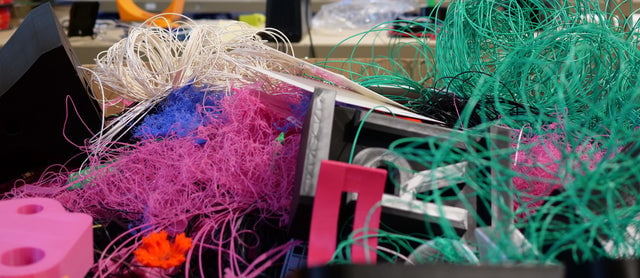
Why is 3D printing scrap so hard to recycle? The 3D printing industry faces many of the same issues as others that use plastic, in addition to some process-specific challenges. Let’s take a look.
Inconsistent Plastic Supply Quality
All 3D printing filaments are thermoplastics, meaning they can, theoretically, be remelted and reused many times. In reality, however, unless you have control over the entire process from filament to print to waste, you can never be sure that the plastic hasn’t been contaminated through environmental exposure or the presence of dyes, composites, plasticizers, and other additives.
For example, high-quality PLA can only be recycled back into high-quality filament if it’s melted down with the same (exact same) high-quality PLA. However, PLA varies significantly by brand when it comes to additives, which is one reason some recycling programs are brand specific.
When the plastic is of unknown origin, it’s typically not recycled back into filament but made into other plastic products, like this planter below.

Niche-Size Market for 3D Plastics
The total waste volume from additive manufacturing is dwarfed by other manufacturing sectors, like water bottles, so it can’t be processed through the existing waste management streams. Popular 3D printing materials like PLA, ABS, and even PETG are not produced at significant enough volumes to have their own recycling categories. They fall under plastics recycling code 7: other.
Mixed with non-recyclable plastics at most plastic recycling facilities, this category is of the lowest grade and either made into plastic lumber, incinerated, or disposed of in a landfill. Other 3D printing materials like resin used for SLA 3D printing are virtually impossible to recycle, but research breakthroughs give hope for the future.
Recycle Programs at the Local Level
On the local level (schools, universities, individual companies), where the process can be more closely monitored, there’s more hope for recycling programs.
Some MakerSpaces and FabLabs offer material-specific collection points, so ask them first before throwing your scraps into the garbage. One example of a local initiative is Auburn University’s Center for Polymers and Advanced Composites, which launched a 3D printing filament recycling program, ReMake, to turn its 3D waste into new filaments without leaving the campus premises.
Some filament manufacturers also try to tackle the issue by offering to recycle their own materials. Australia’s largest 3D printer filament manufacturer, Aurarum, will accept their own PLA back for recycling. They don’t accept all PLA because of the fact that most manufacturers use different grades of plastic, which can lead to an inconsistent recycled product, the company says. Plus, the returned PLA has to be clean of debris or any adhesives, otherwise, it also upsets the process. Aurarum recycles its own internal leftovers in PLA, PETG, and ABS.
At 3DTomorrow, a small UK-based filament maker, reseller, and print shop, owner Callum Coles wanted to dispel the notion that businesses that work with plastics are inherently not eco-friendly. To that end, 3DTomorrow launched a recycling program for customers using their brand of PLA. However, “at the moment, we are not able to turn the material we receive through the print waste recycling scheme back into filament,” Coles says. Instead, the company offers the plastic to other companies that can repurpose it into usable objects.

This plan, too, ran into some common roadblocks. “Our research has shown that although there are a number of small businesses, projects, and individuals that would be suitable to receive print waste, there is currently no way for this waste to be provided in a consistent and streamlined manner,” Coles states on his website. For the smaller projects, they cannot cope with large shipments of print waste, while for the larger projects, they need a consistent supply. To overcome this, 3DTomorrow acts as an intermediary by providing storage (free of charge) and donating the print waste to suitable partners at a level they can manage. “Whether you use 1 spool a week or 100, this program is designed so that everyone can participate.”
Material and printer maker EOS has a closed-loop recycling program for its German, Swiss, and Austrian customers. Acting as an intermediary, EOS will pick up used polymer powder free of charge and send it to the recycling plant at material maker Kajo, where it’s turned into resin pellets for tubes and other products. Since the beginning of the program, more than 150 tons of recycled powder have been re-purposed, and all proceeds were donated to charity. This leads us to the third reason why 3D print recycling is not ubiquitous; money.

Making Money With Good Intentions
The third challenge faced by 3D print recycling is profitability. Recycling programs, in general, are funded through tax dollars or individuals pay to have their recycling picked up at the curb. 3D printed plastic doesn’t fit in the guidelines of most city recycling programs, so your only choice is to pay to have it recycled unless there’s a industrial plastic recycling facility in your area.
The process of collecting, sorting, and processing plastic often makes it more expensive than virgin plastic material, with a few notable exceptions we cover in our guide to recycled filament. Thus consumers are not incentivized to opt for the more environmentally friendly material, other than by their personal or corporate sustainability concerns.
Some of the trailblazers trying to push forward circularity in the additive manufacturing sector despite these challenges are listed below. Bear in mind that they operate locally, so depending on where you are based, the service may not be available.
3D Print Recycling Services
Recycling Fabrik
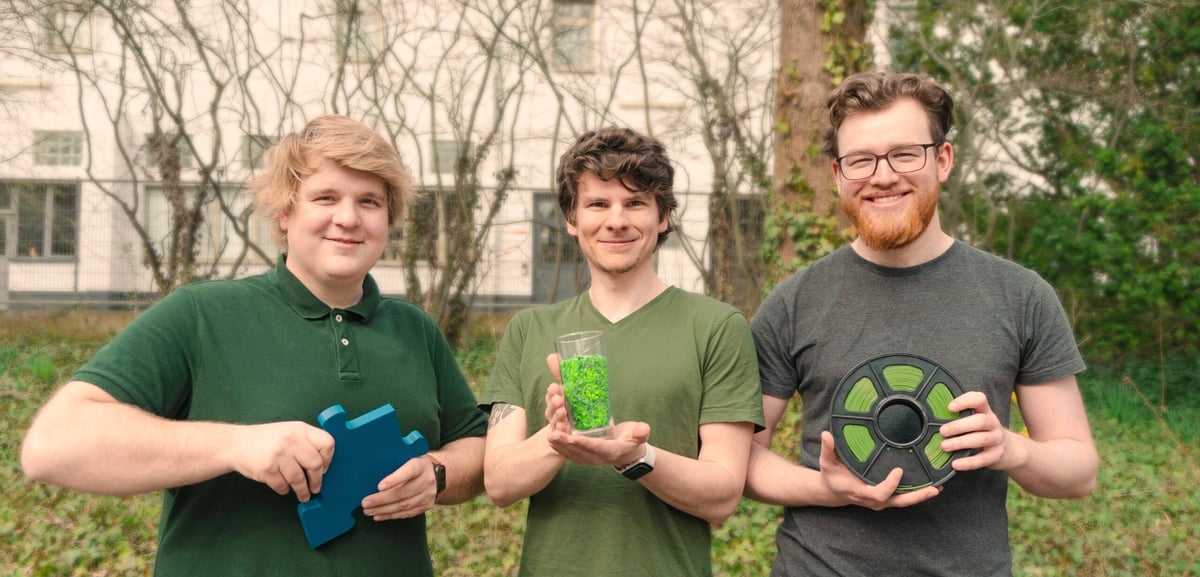
This German start-up offers the most holistic solution to 3D print recycling. At first launch, the company was maybe too ambitious. They invited anyone based in Europe to pack up a box of sorted PLA or PETG scraps (minimum 2 kg for Germany and 15kg for the rest of Europe) and send it to Recycling Fabrik for free with their free shipping label. At their headquarters in Brunswick, the scraps are assessed, cleaned, shredded, melted, and extruded into 100% recycled filament.
You give them your scraps, and they sell it back to you as filament, which is not at all a bad deal. A 1kg spool of 1.75mm PLA goes for about $20 (€20).
As of September 2023, the company has had to alter their business model. So many people took them up on their free recycling offer they had to pause recycling for a while and now, has introduces a new plan.
“We have decided for the time being to tie the awarding of the free shipping labels to purchases so everybody who has bought something from us will get a shipping label,” says company CEO Jörn van Leeuwen. “This allows us to grow in a healthier way and expand our service as quickly as possible and possibly even open collection points in other countries.”
Depending on the quality and volume of your scraps, you are awarded points that can be traded in to get up to 25% off their recycled filament. If based in Germany, you can even send them your plastic spools, which they will reuse for their own rolls.

The company also offers closed-loop recycling programs for enterprises. Once your business has accumulated 100kg of plastic waste, Recycling Fabrik will turn it back into usable filament and sell it back to you. It’s a great way to really foster a sustainable culture at your company.
Schools can participate in recycling challenges and other programs to learn more about recycling and even get educational discounts on their products.
Re-Cycleo by Sculpteo
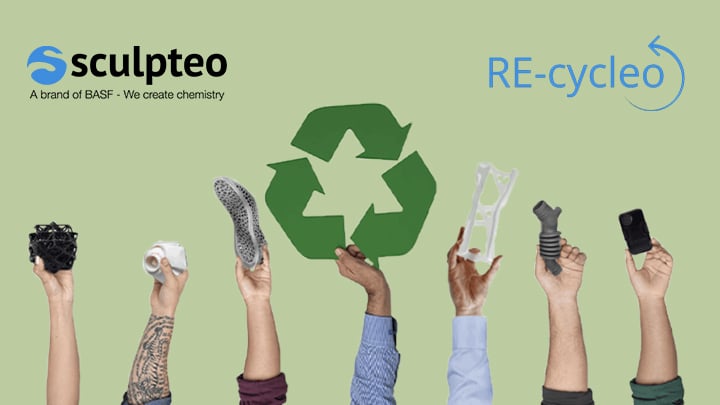
The Re-Cycleo program by 3D printing service provider Sculpteo stands out as it is the only waste management program offered by a service provider in the 3D printing industry, but we hope that will change soon.
Currently, the program is limited in location and material, but Sculpteo hopes to expand if it goes well. Only parts printed by Scupteo qualify for the program, and customers are responsible for shipping them to Sculpteo in France. Locations in North America may come online down the road. The discarded parts will be mixed with other materials to produce pellets for injection-molded products, not filament.
The company currently accepts polished, dyed, or chemically smoothed nylon parts made by Sculpteo on their polymer laser bed fusion machines — PA12 MJF, PA12 SLS, PA11 MJF, and PA11 SLS. Coated, painted, and plated parts will not be accepted. Sculpteo hopes to extend its program to TPU and PP in the future.
You can drop off or mail the parts, including the authorization for destruction form, to their local factory in Villejuif, France. You will not be awarded any money or points by using this service, but sending the parts back may be cheaper than paying for your local waste disposal fee, and you’ll have the peace of mind that you’re doing your part for the planet.
Printerior
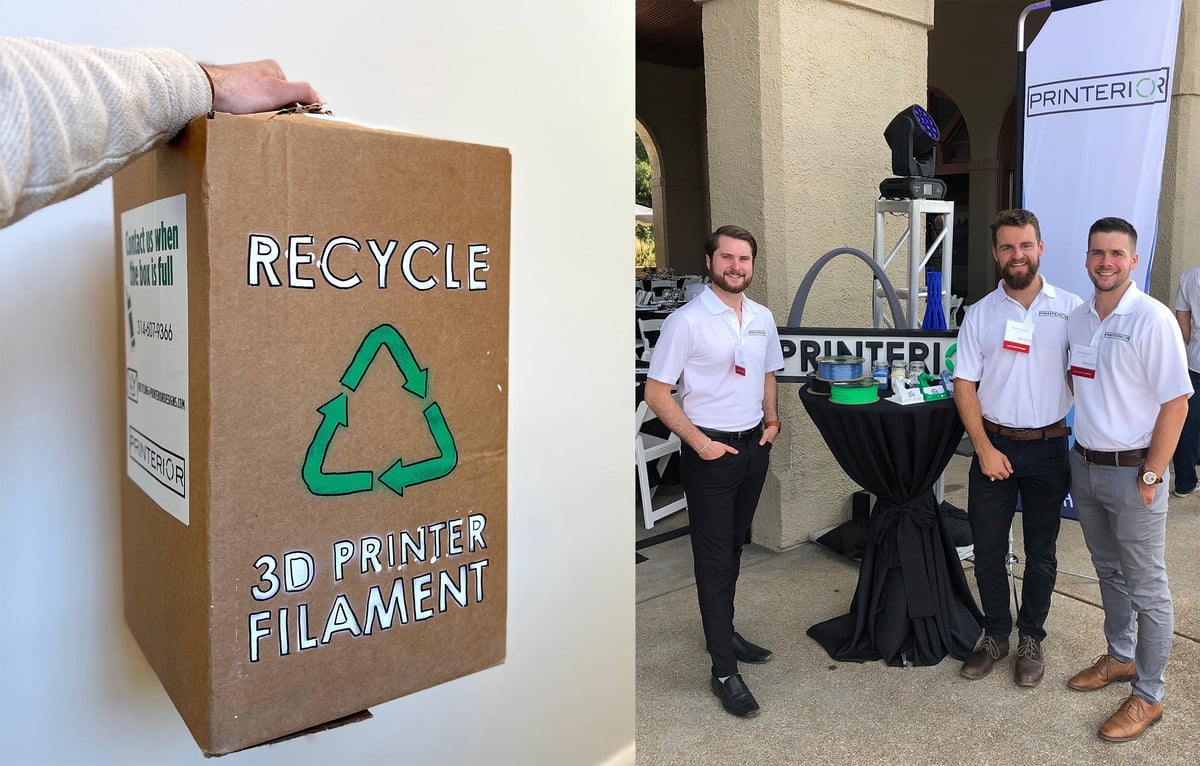
Printerior is a St. Louis, Mo.-based company that offers both 3D printing and recycling services. 3D print scraps made from PLA, PLA+, or PETG must be sorted and clearly labeled before sending them in. This includes special varieties like glow-in-the-dark, wood, or fiber-filled filaments. The company will not cover shipping costs, but if you live near St. Louis, you can drop off your scraps free of charge.
There is no minimum limit on recycling weight, and sorting by color is helpful but not required. Empty spools will not be accepted at the moment, but the company is looking to change that in the future.
Any parts contaminated with paint, glues, or bed adhesives can not be accepted. Per kg, you can earn 280 points to be redeemed for discounted filament purchases in their webshop. With 280 and 1,400 points, you earn a discount of 10% and 50%, respectively.
Private businesses with large waste volumes and educational institutions can contact Printerior directly to determine custom recycling options.
TerraCycle
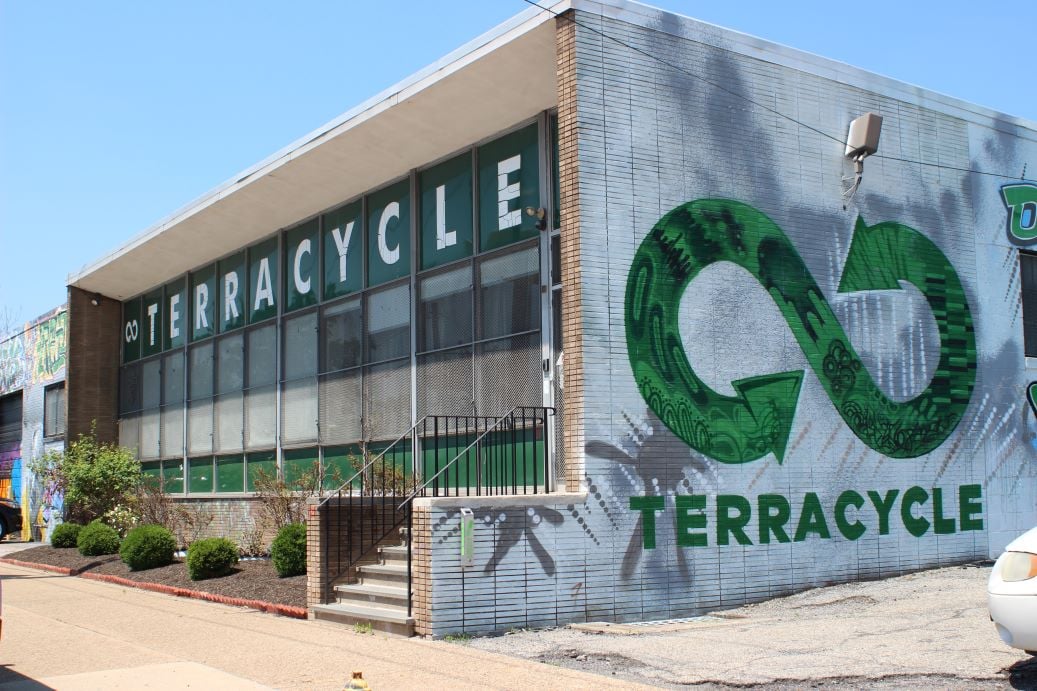
US-based Terracycle specializes in recycling and upcycling hard-to-recycle materials, offering eco-conscious companies and individuals a solution to reduce waste and promote sustainability. It operates in the US, Canada, France, the UK, Netherlands, Australia, and New Zealand.
Essentially you buy a recycling box according to what you’ll put in it. The box for 3D printing materials is $177 for a small (11″ x 11″ x 20″) to $320 for a large (15″ x 15″ x 37″). The price includes shipping the box to you and shipping the full box back to TerraCycle. Unfortunately, each “Zero Waste Box” is limited to geographical areas, so check which offer is available at your location.
Regarding 3D printing scraps, the company offers several Zero Waste Box options, but their use case differs depending on your location. In the US, the 3D Printing Materials box accepts most filament types and spools, including ABS, ASA, PS, HIPS, PP, PE, PET, PETG, PC ABS, HIPS, nylon, and TPU. In mainland UK and Ireland, this box is only for ABS waste and no other type of plastic. In Canada, you can fill it up with ABS, HIPS, nylon, and TPU. For PLA, the slightly cheaper Biodegradable Plastic Zero Waste Box can be ordered.
What does TeraCycle do with your 3D printed scraps once they receive your box? Who knows! TerraCycle doesn’t do plastic recycling itself. Processing is contracted out to third-party companies all over the world. A 2022 BBC documentary and a 2023 Bloomberg news investigation have located Terracycle material bound for recycling in landfills and garbage incineration facilities.
Refactory
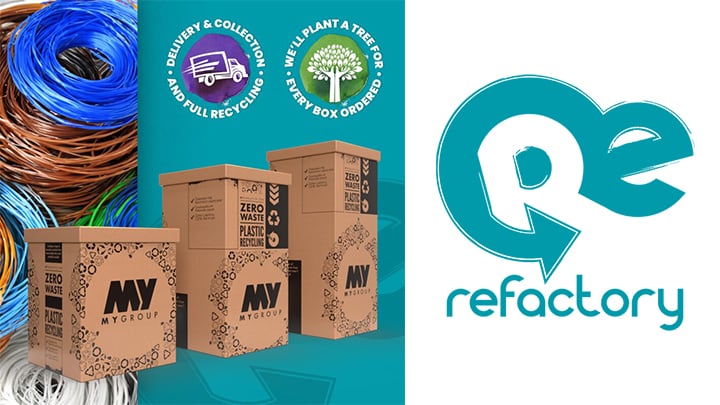
Refactory has the same business model as TerraCycle but is restricted to customers in the United Kingdom and, it does the recycling itself! It doesn’t turn your prints back into filament, but you can buy products made from your plastic scrap on their website, like plain, multi-purpose plastic boards.
Operating from Hull, the company offers a 3D Printing & Filament Recycling Box for ABS, PET, PC, and others, as well as empty spools, plastic packaging, and even Ziplock bags. For PLA, the company also offers a general biodegradable plastic recycling box. The company turns collected waste into new products that can be purchased on its website.
Their recycling boxes are available at 60, 90, and 110 liters with prices starting at $92 (£72) and includes a shipping label as long as the box doesn’t weigh more than 20kg. Recycle will also plant a tree for every box ordered, further offsetting the carbon emissions of your old materials.
3D Printing Waste
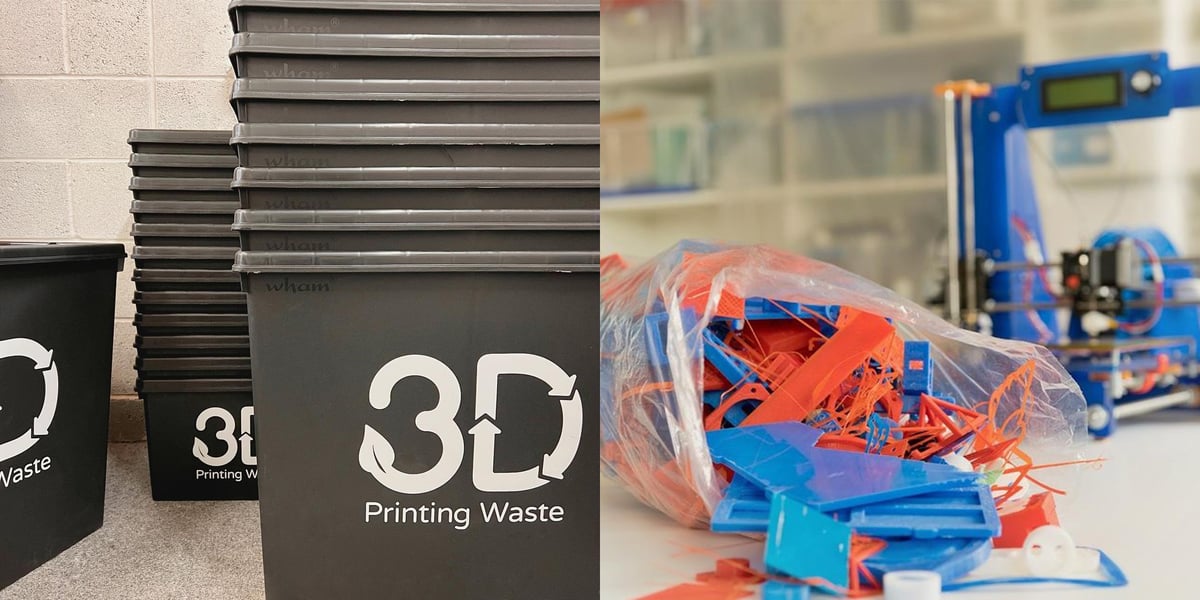
3D Printing Waste is only available to customers located in the UK. Choose between the 45- or 154-liter box, place your order, wait for it to arrive, fill it up, and send it back to their Bradford, West Yorkshire office.
At $69 (£54) for the small and $214 (£168) for the large box, this recycling service is more suited for the dedicated environmentalist because, like Terracycle and Refactory, you won’t receive any credit points or recycled filament. Instead, you’ll receive a good conscience that you kept your valuable filament leftovers from ending up in the environment or incinerated.
The boxes can only be filled with waste PLA and nothing else, so your other 3D printing materials and empty spools will need to sit tight for now. Maybe in the future, more recycling options will be added.
Precious Plastic
This global initiative is all about community-led plastics recycling, not just for 3D prints. Their mission is to reduce plastic waste through recycling, biodegradable materials, zero-waste lifestyles, and anything else that works.
With a combination of people, machines, platforms, and knowledge exchange, Precious Plastic offers several approaches to plastic waste reduction that you could do at home or at your business. Their network includes members, collection sites, recycling workspaces, machine shops, and community points to push forward post-consumer plastic recycling.
The Dutch organization offers a complete processing station for plastics recycling and open-source blueprints for DIY recycling machines that can be built by local workshops and recycling centers.
For 3D printing materials, you can check out their interactive map and, with some luck, find an appropriate recycling site near you for your failed 3D prints. If not, why not open up a new collection or recycling site and grow the network?
License: The text of "3D Print Recycling Services – The Ultimate Guide" by All3DP Pro is licensed under a Creative Commons Attribution 4.0 International License.



